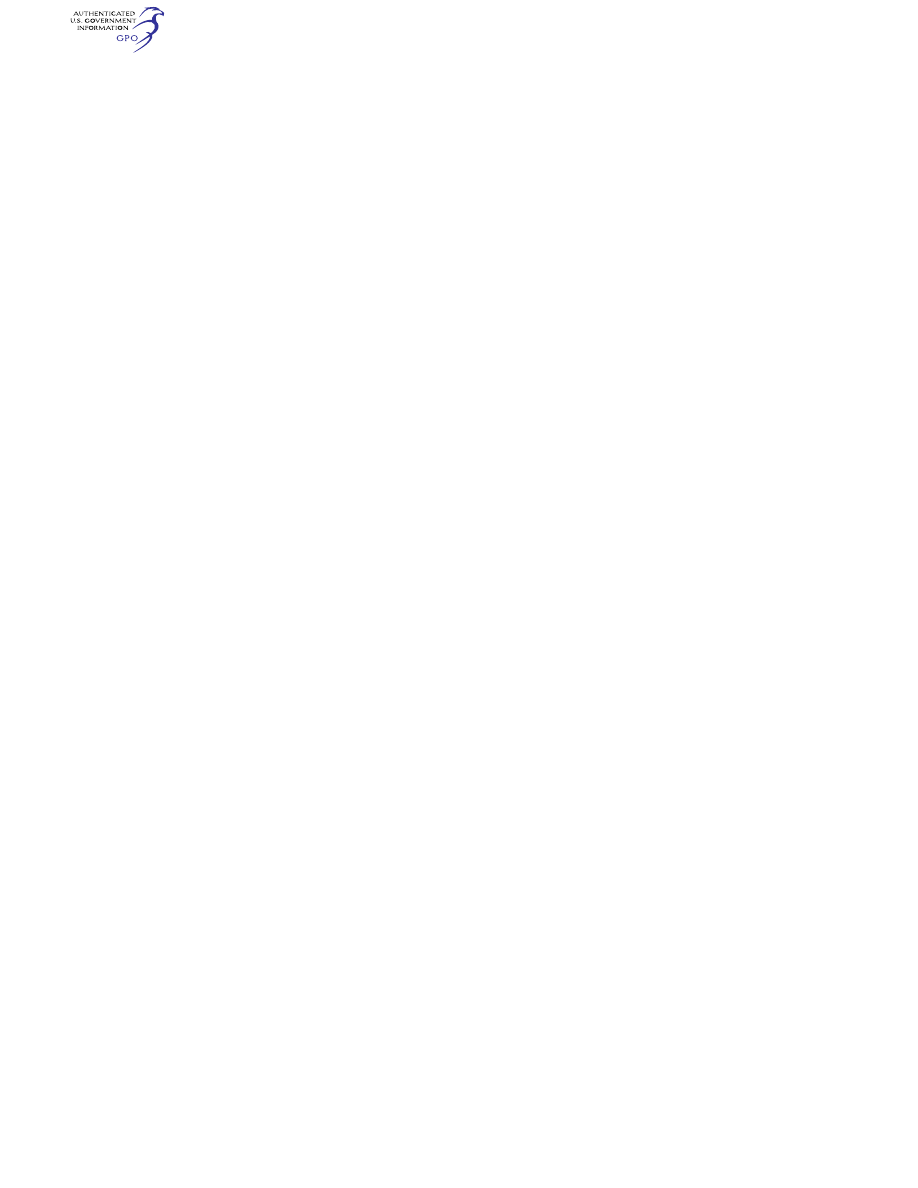
477
Federal Aviation Administration, DOT
§ 26.33
structural maintenance program (here-
after referred to as LOV) approved
under § 25.571 of this subchapter, § 26.21,
or this section. Extending an LOV is a
major design change. The applicant
must comply with the relevant provi-
sions of subparts D or E of part 21 of
this subchapter and paragraph (b) of
this section.
(b)
Extended limit of validity. Each per-
son applying for an extended LOV must
comply with the following require-
ments:
(1) Establish an extended LOV that
corresponds to the period of time, stat-
ed as a number of total accumulated
flight cycles or flight hours or both,
during which it is demonstrated that
widespread fatigue damage will not
occur in the airplane. This demonstra-
tion must include an evaluation of air-
plane structural configurations and be
supported by test evidence and analysis
at a minimum and, if available, service
experience, or service experience and
teardown inspection results, of high-
time airplanes of similar structural de-
sign, accounting for differences in op-
erating conditions and procedures. The
airplane structural configurations to
be evaluated include—
(i) All model variations and deriva-
tives approved under the type certifi-
cate for which approval for an exten-
sion is sought; and
(ii) All structural modifications to
and replacements for the airplane
structural configurations specified in
paragraph (b)(1)(i) of this section, man-
dated by airworthiness directive, up to
the date of approval of the extended
LOV.
(2) Establish a revision or supple-
ment, as applicable, to the Airworthi-
ness Limitations section (ALS) of the
Instructions for Continued Airworthi-
ness required by § 25.1529 of this sub-
chapter, and submit it to the respon-
sible Aircraft Certification Service of-
fice for approval. The revised ALS or
supplement to the ALS must include
the applicable extended LOV estab-
lished under paragraph (b)(1) of this
section.
(3) Develop the maintenance actions
determined by the WFD evaluation per-
formed in paragraph (b)(1) of this sec-
tion to be necessary to preclude WFD
from occurring before the airplane
reaches the proposed extended LOV.
These maintenance actions must be
documented as airworthiness limita-
tion items in the ALS and submitted to
the responsible Aircraft Certification
Service office for approval.
[Docket No. FAA–2006–24281, 75 FR 69782,
Nov. 15, 2010, as amended by Doc. No. FAA–
2018–0119, Amdt. 26–7, 83 FR 9169, Mar. 5, 2018]
Subpart D—Fuel Tank
Flammability
S
OURCE
: Docket No. FAA–2005–22997, 73 FR
42499, July 21, 2008, unless otherwise noted.
§ 26.31
Definitions.
For purposes of this subpart—
(a)
Fleet Average Flammability Expo-
sure has the meaning defined in Appen-
dix N of part 25 of this chapter.
(b)
Normally Emptied means a fuel
tank other than a Main Fuel Tank.
Main Fuel Tank is defined in 14 CFR
25.981(b).
§ 26.33
Holders of type certificates:
Fuel tank flammability.
(a)
Applicability. This section applies
to U.S. type certificated transport cat-
egory, turbine-powered airplanes, other
than those designed solely for all-cargo
operations, for which the State of Man-
ufacture issued the original certificate
of airworthiness or export airworthi-
ness approval on or after January 1,
1992, that, as a result of original type
certification or later increase in capac-
ity have:
(1) A maximum type-certificated pas-
senger capacity of 30 or more, or
(2) A maximum payload capacity of
7,500 pounds or more.
(b)
Flammability Exposure Analysis. (1)
General. Within 150 days after Decem-
ber 26, 2008, holders of type certificates
must submit for approval to the re-
sponsible Aircraft Certification Service
office a flammability exposure analysis
of all fuel tanks defined in the type de-
sign, as well as all design variations
approved under the type certificate
that affect flammability exposure. This
analysis must be conducted in accord-
ance with Appendix N of part 25 of this
chapter.
(2)
Exception. This paragraph (b) does
not apply to—
VerDate Sep<11>2014
09:06 Jun 28, 2024
Jkt 262046
PO 00000
Frm 00487
Fmt 8010
Sfmt 8010
Y:\SGML\262046.XXX
262046
jspears on DSK121TN23PROD with CFR

478
14 CFR Ch. I (1–1–24 Edition)
§ 26.33
(i) Fuel tanks for which the type cer-
tificate holder has notified the FAA
under paragraph (g) of this section that
it will provide design changes and serv-
ice instructions for Flammability Re-
duction Means or an Ignition Mitiga-
tion Means (IMM) meeting the require-
ments of paragraph (c) of this section.
(ii) Fuel tanks substantiated to be
conventional unheated aluminum wing
tanks.
(c)
Design Changes. For fuel tanks
with a Fleet Average Flammability Ex-
posure exceeding 7 percent, one of the
following design changes must be
made.
(1)
Flammability Reduction Means
(FRM). A means must be provided to
reduce the fuel tank flammability.
(i) Fuel tanks that are designed to be
Normally Emptied must meet the
flammability exposure criteria of Ap-
pendix M of part 25 of this chapter if
any portion of the tank is located with-
in the fuselage contour.
(ii) For all other fuel tanks, the FRM
must meet all of the requirements of
Appendix M of part 25 of this chapter,
except, instead of complying with para-
graph M25.1 of this appendix, the Fleet
Average Flammability Exposure may
not exceed 7 percent.
(2)
Ignition Mitigation Means (IMM). A
means must be provided to mitigate
the effects of an ignition of fuel vapors
within the fuel tank such that no dam-
age caused by an ignition will prevent
continued safe flight and landing.
(d)
Service Instructions. No later than
December 27, 2010, holders of type cer-
tificates required by paragraph (c) of
this section to make design changes
must meet the requirements specified
in either paragraph (d)(1) or (d)(2) of
this section. The required service in-
structions must identify each airplane
subject to the applicability provisions
of paragraph (a) of this section.
(1)
FRM. The type certificate holder
must submit for approval by the re-
sponsible Aircraft Certification Service
office design changes and service in-
structions for installation of fuel tank
flammability reduction means (FRM)
meeting the criteria of paragraph (c) of
this section.
(2)
IMM. The type certificate holder
must submit for approval by the re-
sponsible Aircraft Certification Service
office design changes and service in-
structions for installation of fuel tank
IMM that comply with 14 CFR 25.981(c)
in effect on December 26, 2008.
(e)
Instructions for Continued Air-
worthiness (ICA). No later than Decem-
ber 27, 2010, holders of type certificates
required by paragraph (c) of this sec-
tion to make design changes must sub-
mit for approval by the responsible
Aircraft Certification Service office,
critical design configuration control
limitations (CDCCL), inspections, or
other procedures to prevent increasing
the flammability exposure of any tanks
equipped with FRM above that per-
mitted under paragraph (c)(1) of this
section and to prevent degradation of
the performance of any IMM provided
under paragraph (c)(2) of this section.
These CDCCL, inspections, and proce-
dures must be included in the Air-
worthiness Limitations Section (ALS)
of the ICA required by 14 CFR 25.1529 or
paragraph (f) of this section. Unless
shown to be impracticable, visible
means to identify critical features of
the design must be placed in areas of
the airplane where foreseeable mainte-
nance actions, repairs, or alterations
may compromise the critical design
configuration limitations. These visi-
ble means must also be identified as a
CDCCL.
(f)
Airworthiness Limitations. Unless
previously accomplished, no later than
December 27, 2010, holders of type cer-
tificates affected by this section must
establish an ALS of the maintenance
manual or ICA for each airplane con-
figuration evaluated under paragraph
(b)(1) of this section and submit it to
the responsible Aircraft Certification
Service office for approval. The ALS
must include a section that contains
the CDCCL, inspections, or other pro-
cedures developed under paragraph (e)
of this section.
(g)
Compliance Plan for Flammability
Exposure Analysis. Within 90 days after
December 26, 2008, each holder of a type
certificate required to comply with
paragraph (b) of this section must sub-
mit to the responsible Aircraft Certifi-
cation Service office a compliance plan
consisting of the following:
(1) A proposed project schedule for
submitting the required analysis, or a
determination that compliance with
VerDate Sep<11>2014
09:06 Jun 28, 2024
Jkt 262046
PO 00000
Frm 00488
Fmt 8010
Sfmt 8010
Y:\SGML\262046.XXX
262046
jspears on DSK121TN23PROD with CFR

479
Federal Aviation Administration, DOT
§ 26.35
paragraph (b) of this section is not re-
quired because design changes and
service instructions for FRM or IMM
will be developed and made available as
required by this section.
(2) A proposed means of compliance
with paragraph (b) of this section, if
applicable.
(h)
Compliance Plan for Design
Changes and Service Instructions. Within
210 days after December 26, 2008, each
holder of a type certificate required to
comply with paragraph (d) of this sec-
tion must submit to the responsible
Aircraft Certification Service office a
compliance plan consisting of the fol-
lowing:
(1) A proposed project schedule, iden-
tifying all major milestones, for meet-
ing the compliance dates specified in
paragraphs (d), (e) and (f) of this sec-
tion.
(2) A proposed means of compliance
with paragraphs (d), (e) and (f) of this
section.
(3) A proposal for submitting a draft
of all compliance items required by
paragraphs (d), (e) and (f) of this sec-
tion for review by the responsible Air-
craft Certification Service office not
less than 60 days before the compliance
times specified in those paragraphs.
(4) A proposal for how the approved
service information and any necessary
modification parts will be made avail-
able to affected persons.
(i) Each affected type certificate
holder must implement the compliance
plans, or later revisions, as approved
under paragraph (g) and (h) of this sec-
tion.
[Doc. No. FAA–2005–22997, 73 FR 42499, July
21, 2008, as amended by Amdt. 26–3, 74 FR
31619, July 2, 2009; Doc. No. FAA–2018–0119,
Amdt. 26–7, 83 FR 9169, Mar. 5, 2018]
§ 26.35
Changes to type certificates af-
fecting fuel tank flammability.
(a)
Applicability. This section applies
to holders and applicants for approvals
of the following design changes to any
airplane subject to 14 CFR 26.33(a):
(1) Any fuel tank designed to be Nor-
mally Emptied if the fuel tank instal-
lation was approved pursuant to a sup-
plemental type certificate or a field ap-
proval before December 26, 2008;
(2) Any fuel tank designed to be Nor-
mally Emptied if an application for a
supplemental type certificate or an
amendment to a type certificate was
made before December 26, 2008 and if
the approval was not issued before De-
cember 26, 2008; and
(3) If an application for a supple-
mental type certificate or an amend-
ment to a type certificate is made on
or after December 26, 2008, any of the
following design changes:
(i) Installation of a fuel tank de-
signed to be Normally Emptied,
(ii) Changes to existing fuel tank ca-
pacity, or
(iii) Changes that may increase the
flammability exposure of an existing
fuel tank for which FRM or IMM is re-
quired by § 26.33(c).
(b)
Flammability Exposure Analysis—(1)
General. By the times specified in para-
graphs (b)(1)(i) and (b)(1)(ii) of this sec-
tion, each person subject to this sec-
tion must submit for approval a flam-
mability exposure analysis of the aux-
iliary fuel tanks or other affected fuel
tanks, as defined in the type design, to
the responsible Aircraft Certification
Service office. This analysis must be
conducted in accordance with Appendix
N of part 25 of this chapter.
(i) Holders of supplemental type cer-
tificates and field approvals: Within 12
months of December 26, 2008,
(ii) Applicants for supplemental type
certificates and for amendments to
type certificates: Within 12 months
after December 26, 2008, or before the
certificate is issued, whichever occurs
later.
(2)
Exception. This paragraph does not
apply to—
(i) Fuel tanks for which the type cer-
tificate holder, supplemental type cer-
tificate holder, or field approval holder
has notified the FAA under paragraph
(f) of this section that it will provide
design changes and service instructions
for an IMM meeting the requirements
of § 25.981(c) in effect December 26, 2008;
and
(ii) Fuel tanks substantiated to be
conventional unheated aluminum wing
tanks.
(c)
Impact Assessment. By the times
specified in paragraphs (c)(1) and (c)(2)
of this section, each person subject to
paragraph (a)(1) of this section holding
an approval for installation of a Nor-
mally Emptied fuel tank on an airplane
VerDate Sep<11>2014
09:06 Jun 28, 2024
Jkt 262046
PO 00000
Frm 00489
Fmt 8010
Sfmt 8010
Y:\SGML\262046.XXX
262046
jspears on DSK121TN23PROD with CFR


